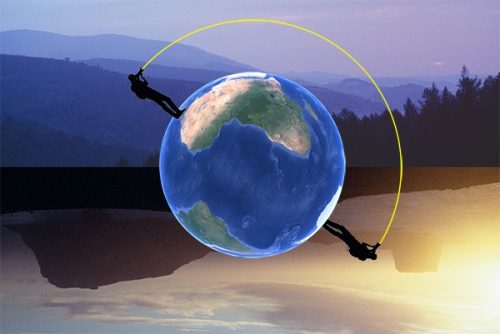
With this project, the concept of antipodes (literally: „opposing feet“) was physically realised and documented. Two performers – Jörg Jozwiak und Ralf Kleimann – stood exactly opposite each other and thus at the greatest possible distance on the earth. The work included that the two people simultaneously pressed the shutter of a camera whilst facing in the exact direction of the other person, hypothetically around the bend of the earth. Apart from this line-up, various maps form parts of this project.
Note: This documentation of the project includes illustrations drawn from Google Earth. This tool was not available in 2003!
Preparations. A location situated opposite Düsseldorf (where the idea for this project was born) lies more than 1400 km southeast of New Zealand’s capital Wellington in a stormy maritime area remote from all ocean shipping lanes. The nearest place which is inhabited is 811 km away: Pitt Island in the Chatham Archipalego – 65 km² large and occupied in 2003 by 38 people. A line projected back from Pitt Island, through the centre of the earth, terminates in the Cévennes National Park in southern France.
The first step to designate a suitable spot for the line-up was to determine Pitt Island’s antipodal area in France cartographically. The desired pair of meeting points should be situated above the average land height, and not be covered by trees. Elevated and vegetation-free sites were sought after in the interest of long-distance photographic views. After identifying elevations and classifying the vegetation density on both sides, the maps were correlated and overlaps of potentially interesting areas marked. It turned out that – particularly due to the dense forests on the French side – less than 10% of the total area of Pitt Island/Pitt’s antipodes were suitable. However, 11 pairs of points seemed promising.
The next step was to decide about the most suitable pair of antipodes on site. In September 2003, the “southern antipode“ Ralf Kleimann arrived on Pitt Island and Jörg Jozwiak, the ”northern antipode“, in the Cévennes. By means of GPS, the charted points were located in the terrain, marked on the ground, and their suitability discussed on the phone.
Pitt Island could only be reached with the help of local fishermen, or by chartering a small aircraft from the main island of the archipelago. As a result of the bad weather, it is sometimes impossible to cross the 30 km wide Pitt Strait between the islands for days or even weeks. These conditions result in the success of the project becoming a matter of chance.
The line-up. It was agreed that the event should take place on September 27th at 07:37:00 Central European Summer Time = 18:22:00 Chatham Islands Standard Time. At this time the sun would be rising on the French side and setting over the Chatham Islands. Only at this time of the day would both antipodes be exposed to some natural light simultaneously. At exactly this moment (“to the precise second”), and at antipodal co-ordinates determined on the meter, the northern antipode focused his camera on the horizon at a direction of 108° (east-southeast), whilst the southern antipode did the same, facing the complementary angle (288°; west-nothwest). In this way they were looking at each other, and documented this glance (as seen on the two photos displayed to the left and to the right).
A TV-Documentary was filmed about this project (in German) and was broadcast in “52° Süd – Von Kartenlesern und Weltensammlern”, ARTE TV. It was written, directed and produced by Thomas Schmitt (2005)
